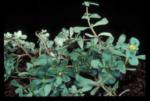Latin name
Portulaca oleracea L.
Family
Portulacaceae
Common name(s)
Pigweed, purslane, common purslane
Synonym(s)
Portulaca marginata Kunth, P. retusa Engelm.; P. oleracea subsp. sylvestris (DC.) Thell., P. oleracea var. opposita Poelln., P. neglecta Mack & Bush
Geographical distribution
Asia: China (Taiwan) and Japan.
South and Southeast Asia: Bangladesh, India, Indonesia, Philippines, Thailand, and Vietnam.
Rest of the world: Argentina, Australia, Belize, Bolivia, Brazil, Burundi, Cameroon, Canada, Central African Republic, Chile, Colombia, Costa Rica, Ecuador, El Salvador, France, Ghana, Germany, Guatemala, Honduras, Iran, Italy, Kenya, Lebanon, Madagascar, Mauritius, Mexico, Nicaragua, Nigeria, Panama, Peru, Portugal, Puerto Rico, Spain, Sudan, Tanzania, Turkey, Uruguay, United States (including Hawaii), Venezuela, Yugoslavia, and Zambia.
Morphology
A succulent, branched, prostrate or spreading annual herb, 10—50—cm—tall.
Stem: smooth and without hair, often purplish, freely branched, nonrooting, cylindrical and erect or more commonly prostrate.
Leaf: thickened, fleshy, flat, shiny, without stalk, and alternately or nearly oppositely arranged on the stem; oblong-obovate with smooth margin and broad rounded tip, 2—40—mm—long.
Inflorescence: few flower heads; flower yellow, sessile, arising from leaf axils and terminals; petals 5, 3—10—mm wide, about as long as the sepals.
Fruit: one-celled spherical capsule, straw-yellow, glossy, 4—8—mm—long, splitting with the upper half falling off like a lid.
Seed: small, oval, glossy black, approximately 0.5—mm in diameter.
Biology and ecology
Adapted to a wide range of environments such as dryland field crops, plantation crops, tall grass prairie, old pasture, maize fields, arable lands, home gardens, roadsides, and waste areas. It prefers moist fertile soils in sunny or slightly shaded areas, but not marshy sites.
Life cycle is completed in 2—4 months in both tropical and temperate countries. Flowers 4—6 weeks after emergence, when the plant has 10—12 leaves. The self-pollinated flowers open on sunny mornings or during bright hot days and last for only a day. The seeds ripen in 14—16 days. The fruit or capsule turns pale yellow and the lid opens, dispersing the seeds.
A single plant can produce as many as 10,000 seeds. Seeds are disseminated by wind, water, and birds. Seed germination requires a temperature of 10—40º C.
Agricultural importance
An alternate host of Dichotomophthora portulacae Mehr. & Fitz, nematodes such as Meloidogyne spp., Pratylenchus minutus Linford, Rotylenchus reniformis Linford & Oliveira, and Heterodera marioni (Cornu) Goody, and viruses that cause tobacco mosaic, groundnut rosette, anemone brown ring, aster yellows, beet curly top, chili veinbanding, clover big vein, tobacco broad ring spot, tobacco etch, and tobacco streak.
Portulaca oleracea is sometimes eaten as salad. It is a source of blue dye and is used to treat tumors. In the Philippines, it is used as pig feed. It is also used as a soil "binder".
Management
Cultural control: shallow cultivation or hoeing for control of seedlings is very effective. The plants that flower should be completely destroyed to prevent the fleshy stems from developing roots and seeds.
Chemical control: preemergence application of pendimethalin or postemergence application of 2,4-D, MCPA, or propanil can be used to control P. oleracea.
Selected references
Galinato MI, Moody K, Piggin CM. 1999. Upland rice weeds of South and Southeast Asia. Manila (Philippines): International Rice Research Institute. 156 p.Holm LG, Plucknett DL, Pancho JV, Herberger JP. 1977. The world's worst weeds. Honolulu, Hawaii (USA): The University Press of Hawaii. 609 p.Merrill ED. 1976. A flora of Manila. Manila (Philippines): Department of the Interior, Bureau of Science. 491 p.Moody K. 1989. Weeds reported in South and Southeast Asia. Manila (Philippines): International Rice Research Institute. 442 p.Soerjani M, Kostermans AJGH, Tjitrosoepomo G. 1987. Weeds of rice in Indonesia. Jakarta (Indonesia): Balai Pustaka. 716 p.W3TROPICOS at http://mobot.mobot.org/Pick/Search/pick.html.
Contributors
JLA Catindig, RT Lubigan, and DE Johnson
